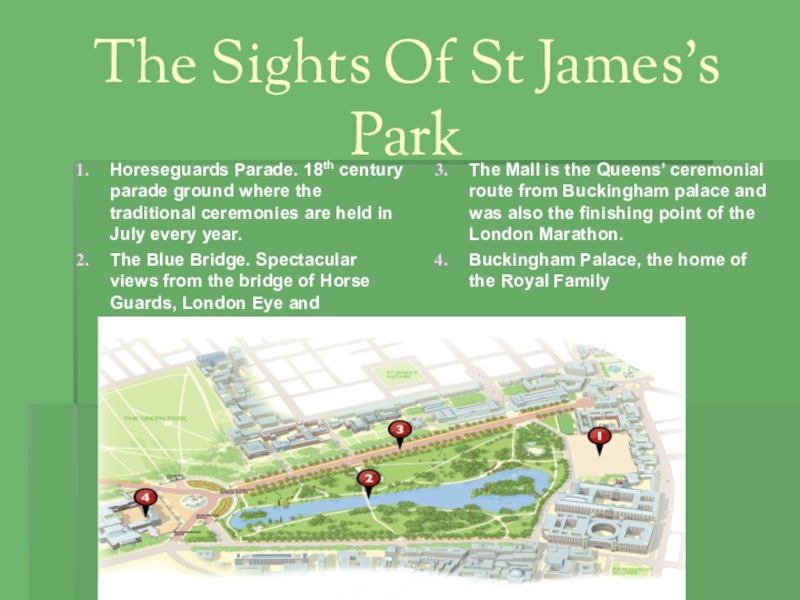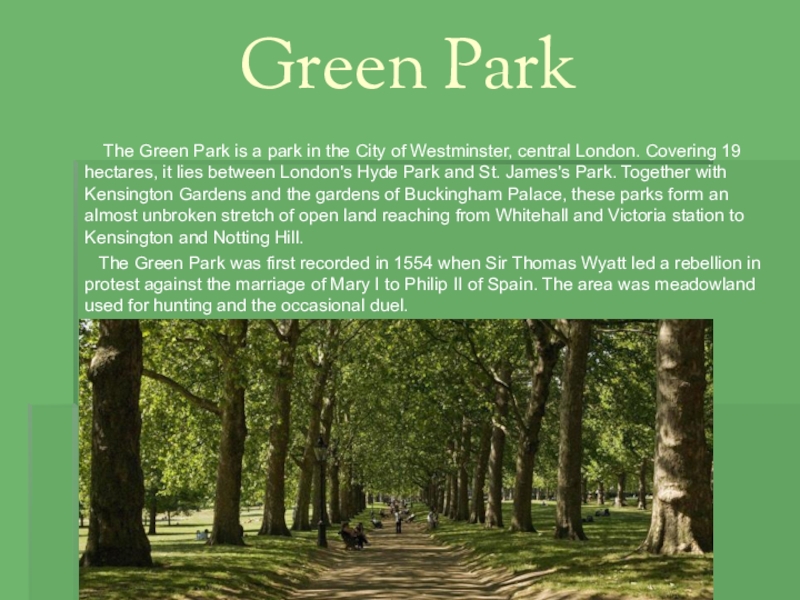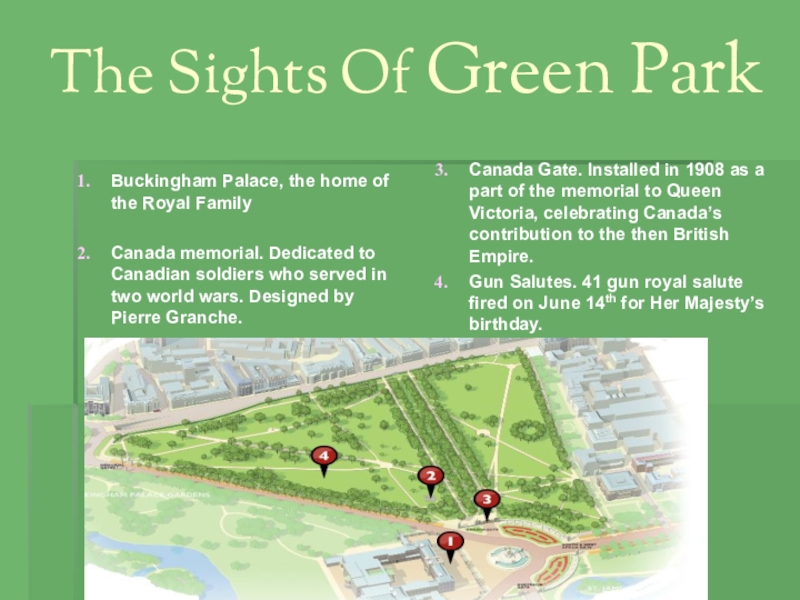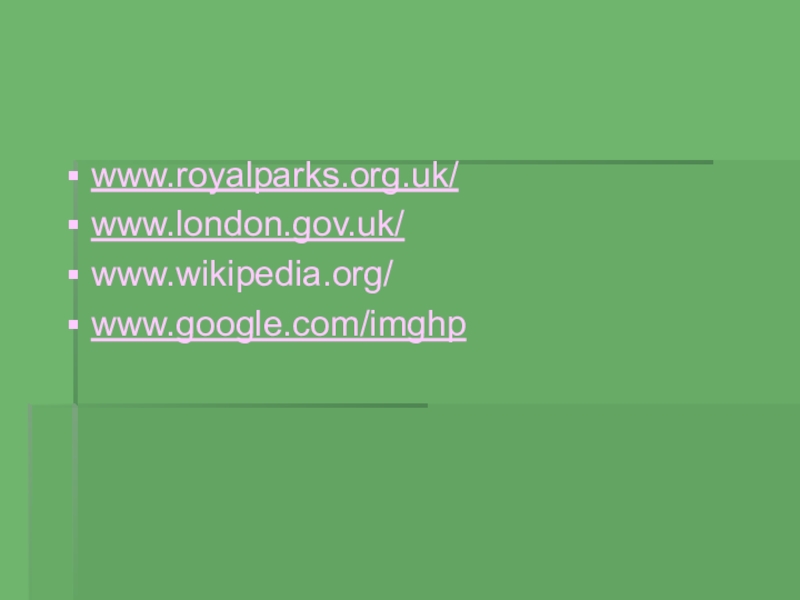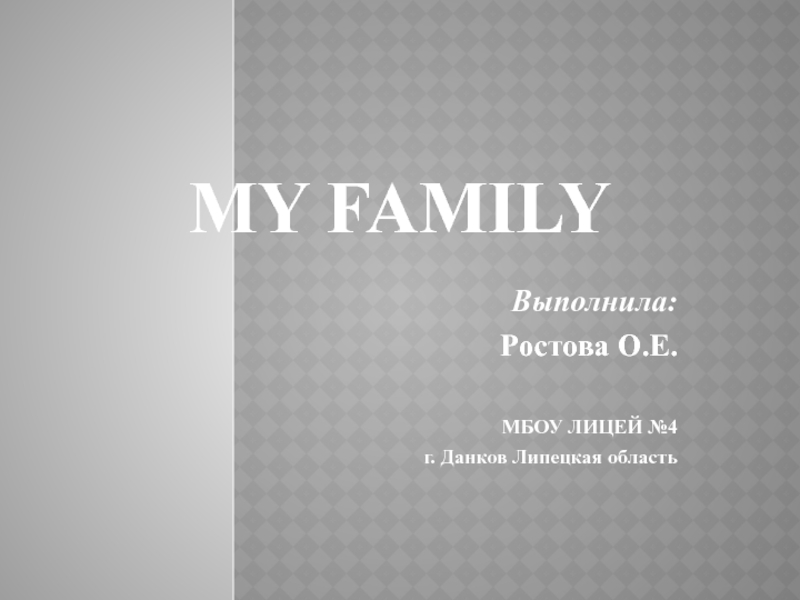- Главная
- Разное
- Образование
- Спорт
- Естествознание
- Природоведение
- Религиоведение
- Французский язык
- Черчение
- Английский язык
- Астрономия
- Алгебра
- Биология
- География
- Геометрия
- Детские презентации
- Информатика
- История
- Литература
- Математика
- Музыка
- МХК
- Немецкий язык
- ОБЖ
- Обществознание
- Окружающий мир
- Педагогика
- Русский язык
- Технология
- Физика
- Философия
- Химия
- Шаблоны, фоны, картинки для презентаций
- Экология
- Экономика
Презентация, доклад по английскому языку The Royal parks of London@
Содержание
- 1. Презентация по английскому языку The Royal parks of London@
- 2. Information About Royal ParksThe Royal Parks of
- 3. Richmond Park Richmond Park is a
- 4. The Sights Of Richmond ParkPembroke Lodge &
- 5. Bushy Park Bushy Park is the
- 6. The Sights Of Bushy ParkWater Gardens.
- 7. Regent’s Park
- 8. The Sights Of Regent’s ParkQueen Mary’s Garden.
- 9. Hyde Park Hyde Park
- 10. The Sights Of Hyde ParkDiana Fountain. It
- 11. Kensington Gardens Kensington
- 12. The Sights Of Kensington GardensItalian Fountains. Ornamental
- 13. Greenwich Park Greenwich Park is a
- 14. The Sights Of Greenwich ParkMeridian line. The
- 15. St James’s Park
- 16. The Sights Of St James’s ParkHoreseguards Parade.
- 17. Green Park The
- 18. The Sights Of Green ParkBuckingham Palace, the
- 19. www.royalparks.org.uk/www.london.gov.uk/www.wikipedia.org/www.google.com/imghp
Слайд 2Information About Royal Parks
The Royal Parks of London are lands originally
With increasing urbanisation of London, some of these were preserved as freely accessible open space and became public parks with the introduction of the Crown Lands Act, 1851. There are today eight parks formally described by this name and they cover almost 2,000 hectares (4,900 acres) of land in Greater London.
Area Of The Royal Parks
Слайд 3Richmond Park
Richmond Park is a park in south-west of
Parks(955 hectares). It is almost famous for shire horses and herds of red and fallow
deer which roam freely within much of the park.
The Park has changed little over the centuries and, although it is
surrounded by human habitation, the varied landscape of hills, woodland gardens and
grasslands set among ancient trees abounds in wildlife.
Royal connections date back over 700 years to when Richmond was part King
Edward I’s Manor of Sheen. In 1625, King Charles I created the walled deer park that
is largely unchanged today.
Слайд 4The Sights Of Richmond Park
Pembroke Lodge & Gardens. Licensed restaurant and
King Henry’s Mound. Spectacular view of St Paul’s Cathedral 10 miles away. The view was created about 1710 and is now legally protected.
Слайд 5Bushy Park
Bushy Park is the second largest of London's
acres) in area. Bushy Park is like a patchwork quilt of English history. It has remains of
medieval farmland, a Tudor deer park, 17th century water gardens and wartime
camps.
Lying north of Hampton Court Palace, the history of the park is inextricably linked to
the palace, yet it has always had its own distinct rural character. The famous Arethusa
'Diana' Fountain forms the centrepiece to the equally famous Chestnut Avenue.
The flat site on which Bushy Park lies has been settled for at least 4,000 years. There
is clear evidence of the medieval field boundaries, with the finest example just south of
the Waterhouse Woodland Gardens, where there are traces of the largest and most
complete medieval field system in Middlesex.
Слайд 6The Sights Of Bushy Park
Water Gardens.
Chestnut Avenue.
Built in 1699 as part of Sir Christopher Wren’s design for a grand state approach to Hampton Court
Слайд 7Regent’s Park
The Regent's Park
In the Middle Ages the land was part of the manor of Tyburn, the property of Barking Abbey. In the Dissolution of the Monasteries, Henry VIII appropriated the land, and it has been Crown property ever since, except for the period between 1649 and 1660. It was set aside as a hunting park, known as Marylebone Park, until 1649. It was then let out in small holdings for hay and dairy produce.
Слайд 8The Sights Of Regent’s Park
Queen Mary’s Garden.
Слайд 9Hyde Park
Hyde Park is one of the
Even before the Norman Conquest, Park belonged to Westminster Abbey, the name was an ancient unit of area. Since the beginning of the dissolution of the monasteries (1536) Henry VIII withdrew it in the treasury, to use for their own amusement hunting for the public it was opened by James I, and under Charles II was the favorite place of Londoners.
Слайд 10The Sights Of Hyde Park
Diana Fountain. It is memorial to Diana,
7 July Memorial. 52 pillars represent the people killed in July 7th bombed in London in 2005.
Speakers’ Corner. Since 1872 people have had a legal right to speak publically here about anything, provided they don’t use obscene language.
Gun Salutes. Fired on the June 2nd to mark Queen Elizabeth II’s coronation and June 10th for The Duke of Edinburgh’s birthday.
Isis, a beautiful bronze by leading British sculptor Simon Gudgeon. By dedicating your own personal plaque you will be helping future generations or city children learn about the natural world, encouraging them to appreciate wildlife and look after the environment.
Слайд 11Kensington Gardens
Kensington Gardens, once the private
immediately to the west of Hyde Park. It began life as a King's playground but it was
three royal women who created the elegant landscape we still enjoy today. The park
covers an area of 111 hectares. It particularly popular for sunbathing and picnics in fine
weather.
An asthma sufferer, the king found the location quiet and the air
salubrious and so he commissioned Sir Christopher Wren to design the
redbrick building that is Kensington Palace. Queen Anne enlarged the Palace
Gardens by 'transferring' 30 acres from Hyde Park and was responsible for
the creation of the Orangery in 1704.
Слайд 12The Sights Of Kensington Gardens
Italian Fountains. Ornamental water garden with fountains,
Bronze statue of Peter Pan, designed by George Frampton and donated by J M Barrie (the author) in 1912.
Round Pound. It is a popular place to see water birds. Created in 1735.
Kensigton Palace. Home of Princess Diana and birth place of Queen Victoria. First used as a royal palace in 1689.
Memorial to Prince Albert. Huge gold and stone statue.
Слайд 13Greenwich Park
Greenwich Park is a former hunting park in
The estate of some 200 acres was originally owned by the Abbey of St. Peter at Ghent, but reverted to the Crown in 1427 and was given by Henry VI to his uncle Humphrey, Duke of Gloucester (Barker 1999). He built a house by the river, Bella Court, and a small castle, called Greenwich Castle as well as Duke Humphrey’s Tower, on the hill. The former evolved first into the Tudor Palace of Placentia and then into the Queen's House and Greenwich Hospital. Greenwich Castle, by now in disrepair, was chosen for the site of the Royal Observatory by Charles II in 1675.
Слайд 14The Sights Of Greenwich Park
Meridian line. The line of 0 degrees
The Observatory. Britain’s first purpose-built scientific research facility. Commissioned in 1675 by King Charles II and designed by Sir Christopher Wren.
Roman Remains. It is a building, probably a temple, dating from AD43 – AD410.
Sundial. 3m triangular metal sundial and floor mosaic installed in 2000 next to the Greenwich Meridian.
Wolfe statue. It is a statue of Greenwich resident General Wolfe, who established British rule in Canada.
Слайд 15St James’s Park
St. James's Park is
Walk the elegant paths of St James's Park today and it is hard to imagine that pigs once grazed here. But, 470 years ago, the St James's area was known mainly for farms, woods and a hospital for women lepers.
St James's Park is the oldest Royal Park in London and is surrounded by three palaces. The most ancient is Westminster, which has now become the Houses of Parliament, St James's Palace and of course, the best known, Buckingham Palace.
Слайд 16The Sights Of St James’s Park
Horeseguards Parade. 18th century parade ground
The Blue Bridge. Spectacular views from the bridge of Horse Guards, London Eye and Buckingham Palace.
The Mall is the Queens’ ceremonial route from Buckingham palace and was also the finishing point of the London Marathon.
Buckingham Palace, the home of the Royal Family
Слайд 17Green Park
The Green Park is a
The Green Park was first recorded in 1554 when Sir Thomas Wyatt led a rebellion in protest against the marriage of Mary I to Philip II of Spain. The area was meadowland used for hunting and the occasional duel.
Слайд 18The Sights Of Green Park
Buckingham Palace, the home of the Royal
Canada memorial. Dedicated to Canadian soldiers who served in two world wars. Designed by Pierre Granche.
Canada Gate. Installed in 1908 as a part of the memorial to Queen Victoria, celebrating Canada’s contribution to the then British Empire.
Gun Salutes. 41 gun royal salute fired on June 14th for Her Majesty’s birthday.
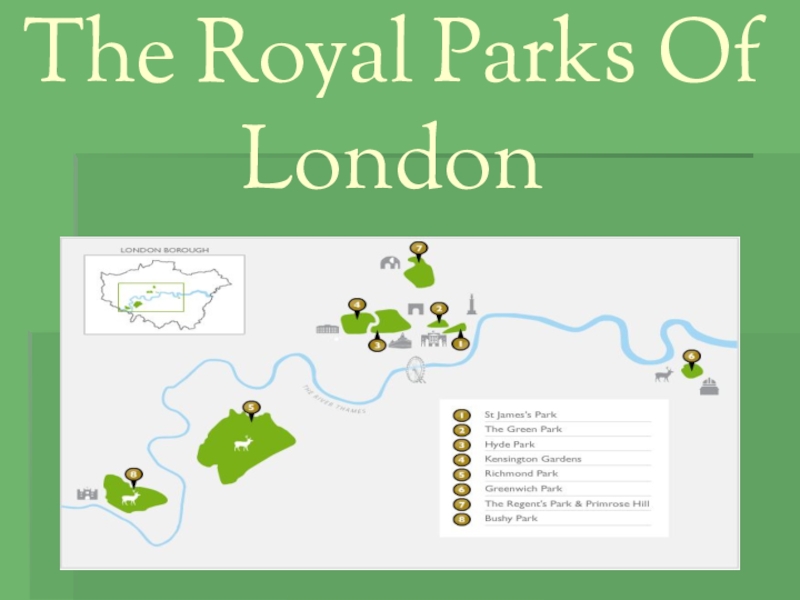
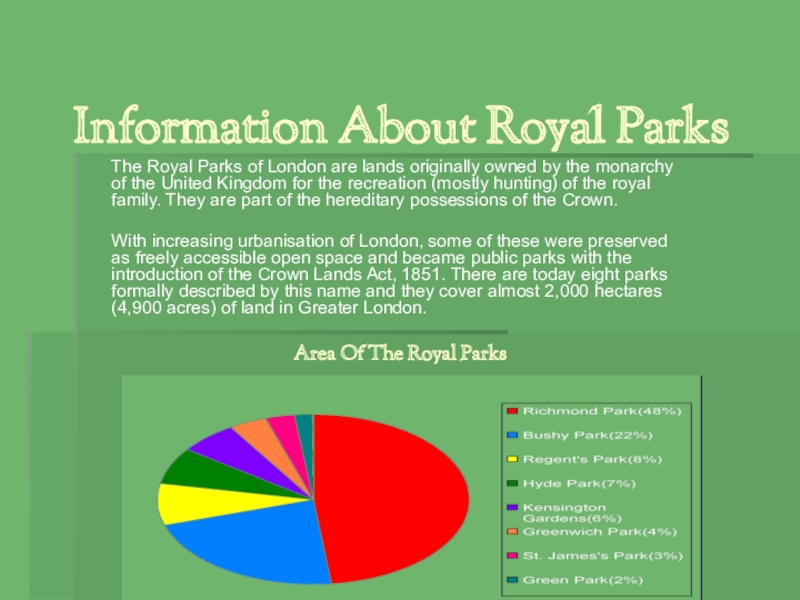
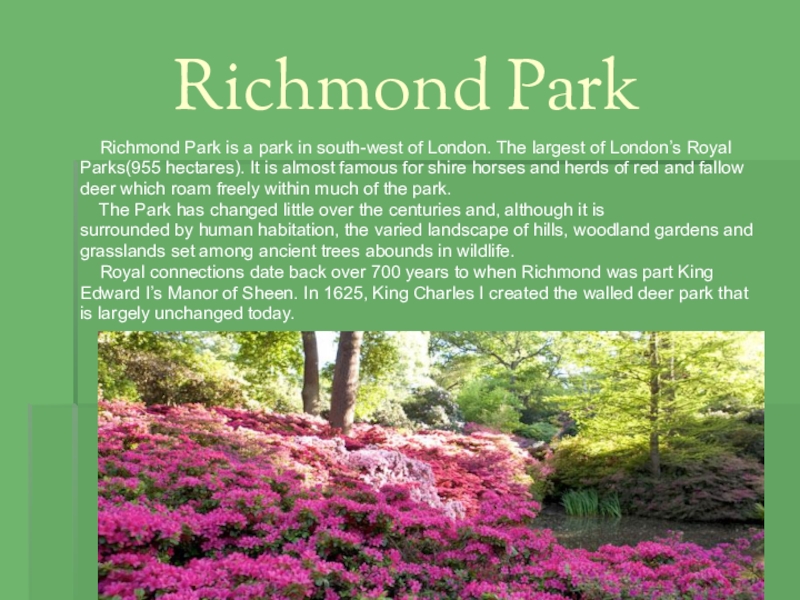
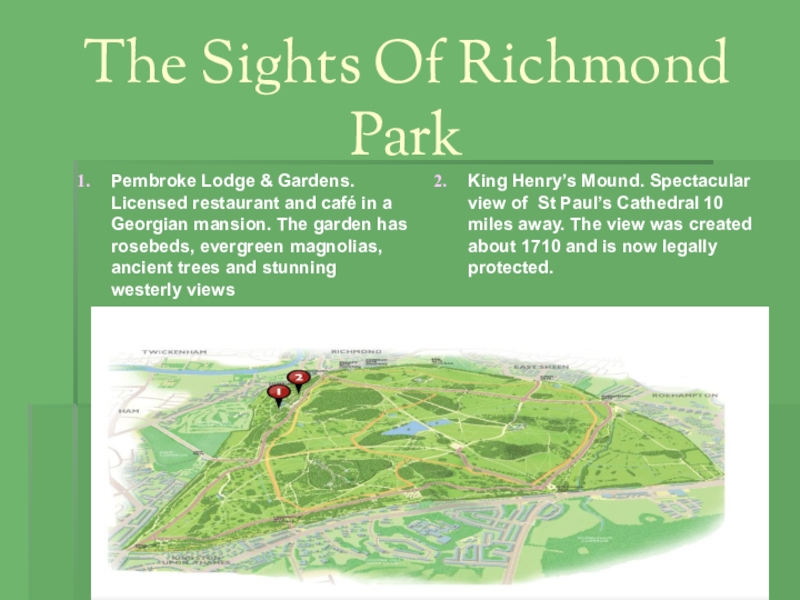
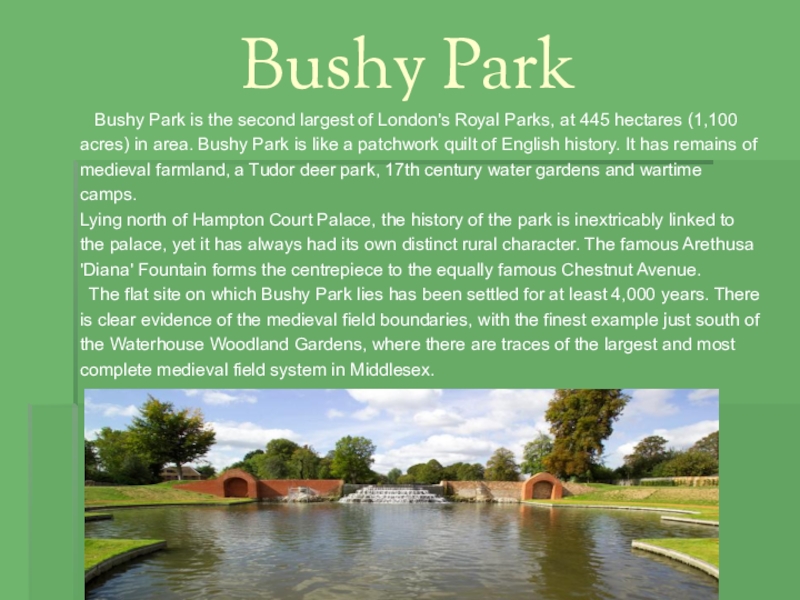
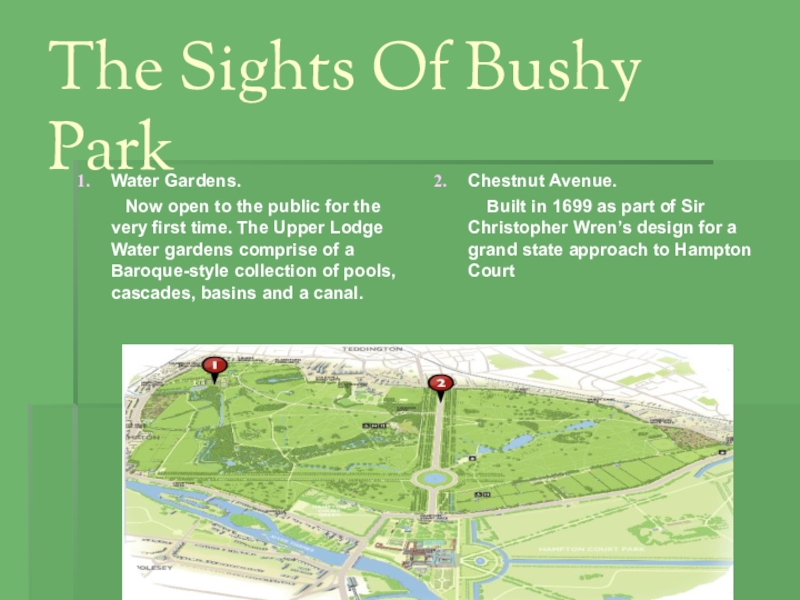
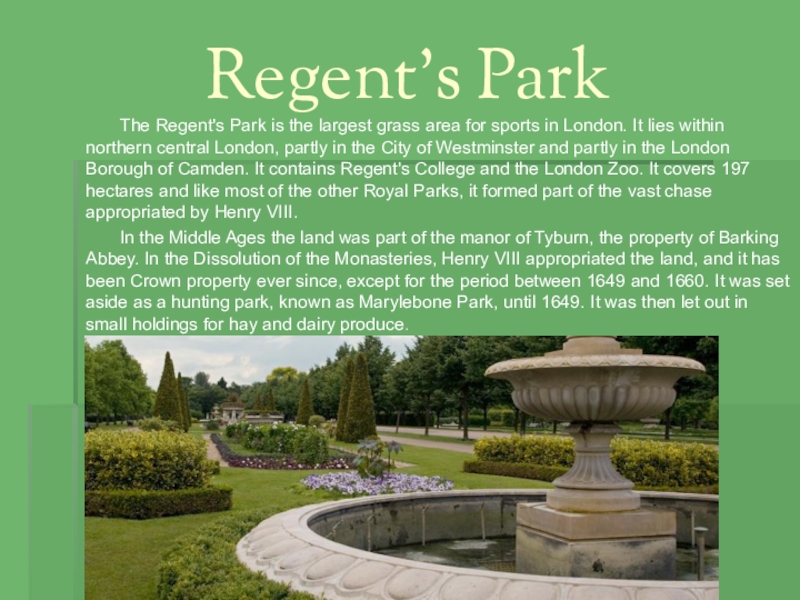
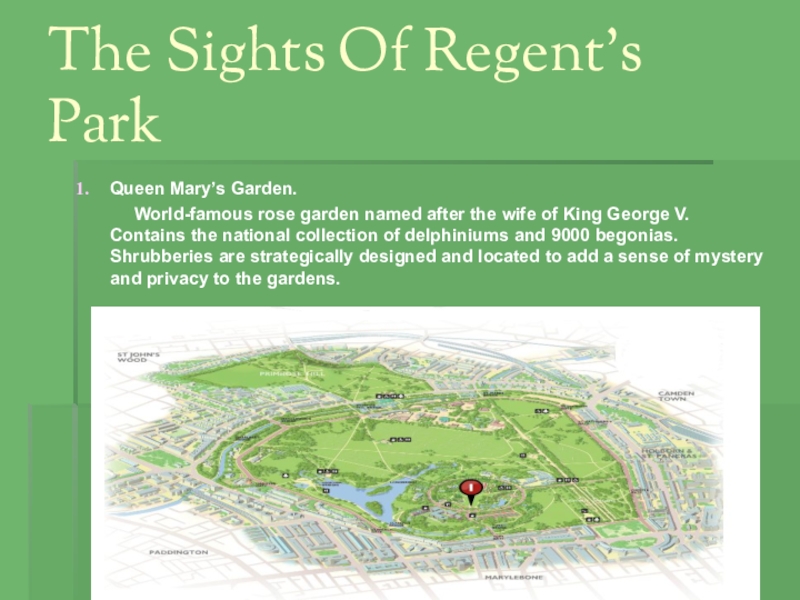
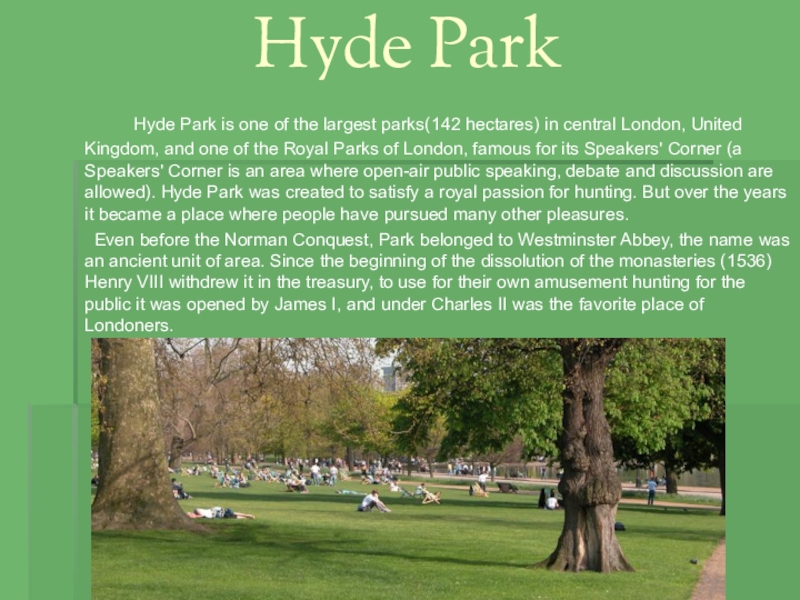
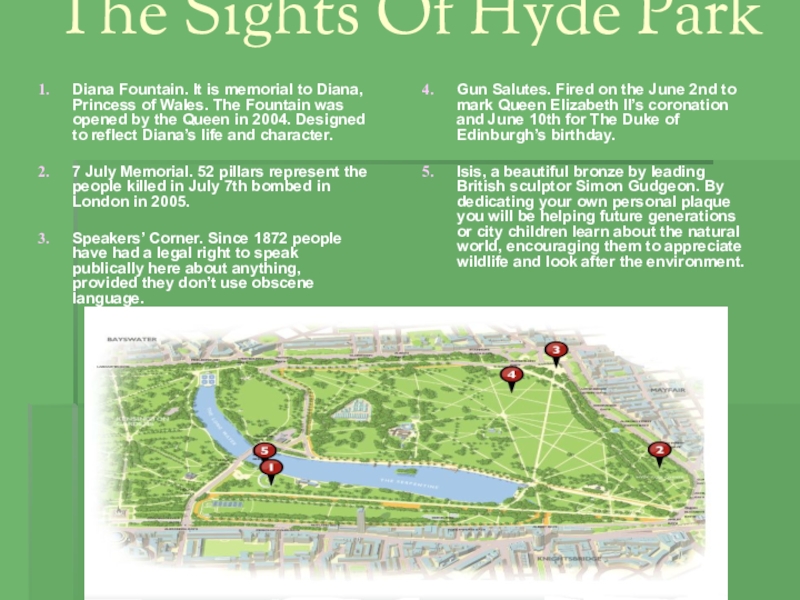
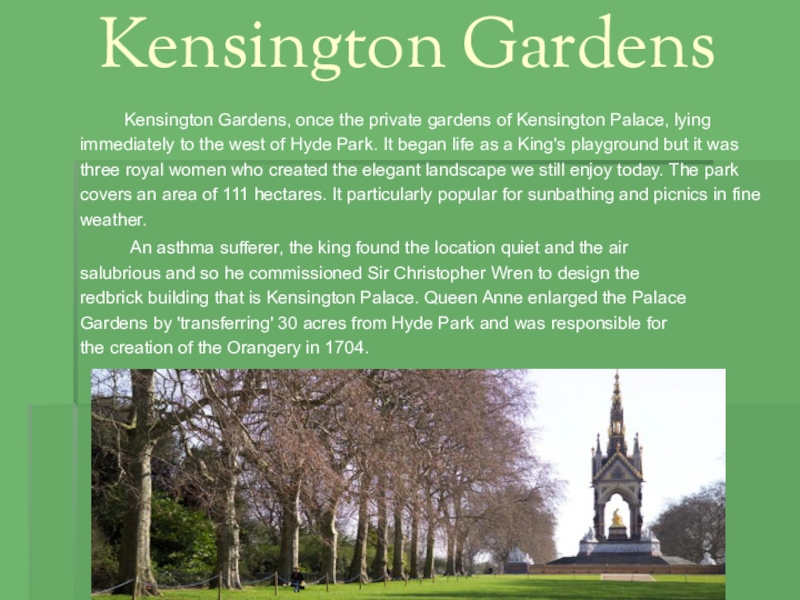
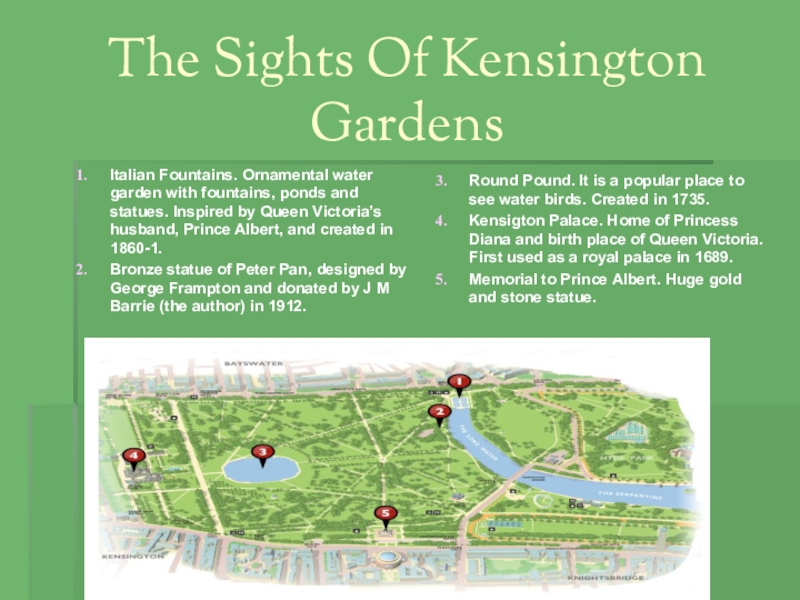
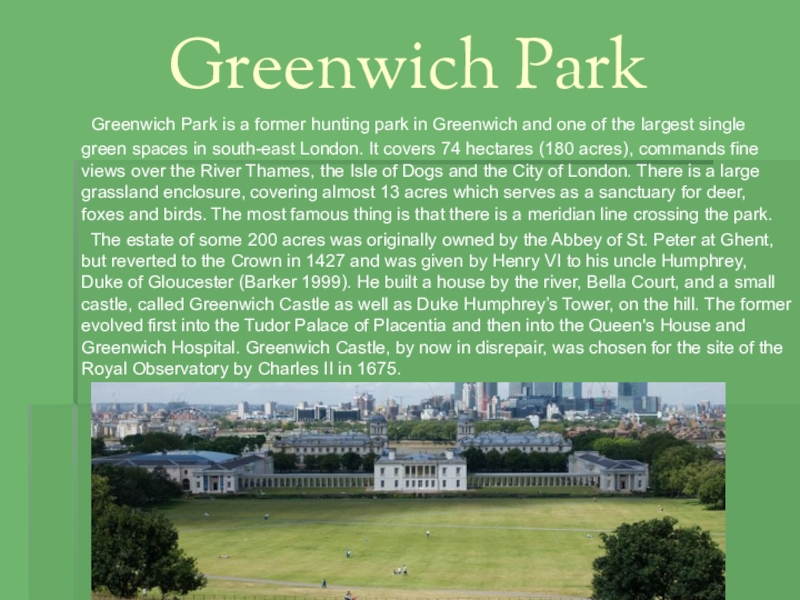
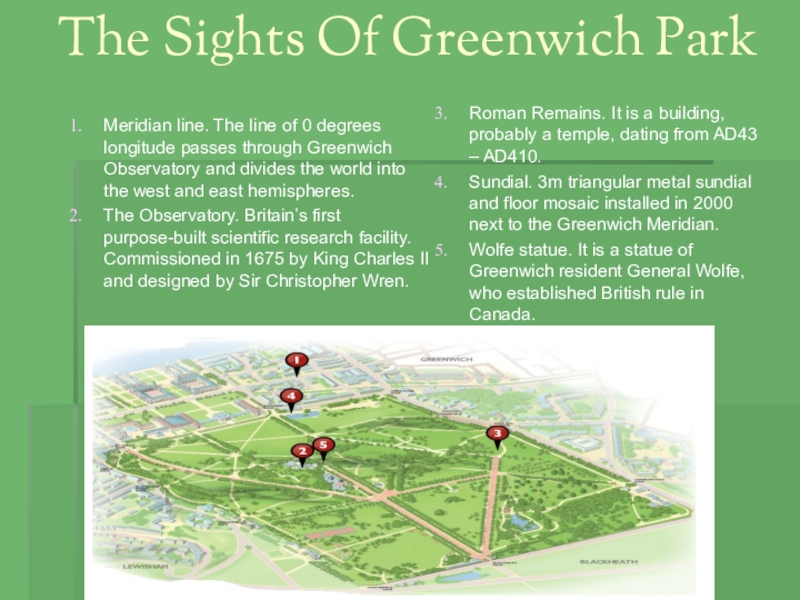
![Презентация по английскому языку The Royal parks of London@ St James’s Park St. James's Park is a 23 St James’s Park St. James's Park is a 23 hectares (57 acres)[1] park](/img/thumbs/b65544b5e2b02f3798405e8d3bfbe5ca-800x.jpg)
